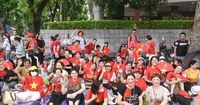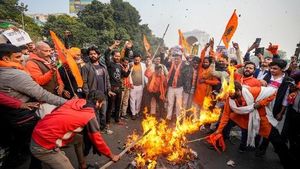As Hanoi gears up to commemorate the 80th anniversary of the August Revolution and National Day on September 2, 2025, the city is alive with anticipation, color, and a palpable sense of history. On the evening of August 21, the first rehearsal for the grand military parade and procession unfolded at the iconic Ba Dinh Square, drawing thousands of citizens and tourists into the very heart of Vietnam's capital. The event, a prelude to one of the nation’s most significant holidays, transformed central Hanoi into a stage for both spectacle and community spirit.
From as early as 11 AM, the streets surrounding Ba Dinh Square—Hung Vuong, Tran Phu, Dien Bien Phu, Nguyen Thai Hoc, and Phan Dinh Phung—began to swell with people. According to Dân trí, these thoroughfares, usually busy but manageable, quickly became packed with a diverse crowd eager for a glimpse of the parade rehearsal. Many came prepared for the long wait, bringing raincoats, snacks, and drinks, determined to secure the perfect vantage point for the evening’s show.
But the quest for the best view wasn’t limited to sidewalks and street corners. Cafés lining the central boulevards became hot commodities, with patrons arriving as early as noon to claim coveted window seats. As reported by CLO, these establishments, especially those on Nguyen Thai Hoc and Hàng Khay, were filled to capacity well before the rehearsal began. For many, these cafés offered not just comfort but an unobstructed panorama of the parade route—a prime spot to witness the meticulously choreographed spectacle below.
Mai Thu, a Hanoi resident from Gia Lam, described her strategy: "Knowing about the parade rehearsal, my friends and I decided to come here early. Even if we can’t stand on the street, sitting here gives us a complete view. I chose this spot days ago after some research." Her sentiment echoed widely, as social media forums and community groups buzzed with tips and recommendations for the best café or restaurant views. The hunt for the ideal spot became an event in itself, blending modern urban culture with the deep-rooted tradition of communal celebration.
Yet, not everyone needed to jostle for a seat or queue for a coffee. For some Hanoi residents, home itself offered the ultimate front-row view. Take Hai Tran, for instance—a young man whose family home on Nguyen Thai Hoc street, just 300 meters from the revered Lang Bac area, features a rooftop perch with a sweeping outlook over the parade route. As Dân trí reported, Hai Tran found himself in a fortunate position, able to enjoy the rehearsal from the comfort of his fifth-floor rooftop, no early arrival required. "I feel like I’ve hit the jackpot," he joked, sharing images of his vantage point on social media. The response was immediate and enthusiastic, with friends and strangers alike reaching out—some even offering to pay for a chance to join him.
Despite the flurry of requests, Hai Tran politely declined, citing safety and security concerns. "This area is reserved for family gatherings," he explained. Still, his story struck a chord, highlighting both the excitement surrounding the event and the lengths to which people would go to be part of this historic moment.
As the afternoon wore on, the atmosphere in Hanoi only intensified. By 5 PM, according to Dân trí, every prime viewing spot—whether in a café, on a balcony, or at a busy intersection—was occupied. The city’s streets were decorated with bright flags and flowers, and the air buzzed with anticipation. Residents and visitors alike joined in, hanging red flags with yellow stars and sharing in the collective pride of the approaching anniversary. The sense of unity was unmistakable, as people from all walks of life came together to mark a milestone eight decades in the making.
For those seeking the best places to watch, local media offered several suggestions. Intersections like Hung Vuong-Nguyen Thai Hoc-Hang Chao, Cua Nam-Trang Thi, Le Duan-Nguyen Thai Hoc, and Hang Khay-Trang Tien were all recommended for their proximity to parade routes and spacious sidewalks. The area around Tran Phu-Nguyen Tri Phuong and Le Hong Phong-Ngoc Ha-Doi Can also provided excellent views, especially as various military and civic units marched by. For those unable to secure a physical spot, technology bridged the gap: over 270 LED screens were installed throughout Hanoi, ensuring that everyone could participate in the festivities, wherever they happened to be.
The meticulous planning extended beyond logistics to public safety. Authorities urged attendees to follow security guidelines and cooperate with officials, a message repeated across both CLO and Dân trí. The sheer scale of the event, with its mix of local enthusiasm and international attention, underscored the importance of maintaining order while fostering a welcoming atmosphere.
Of course, the parade rehearsal was more than just a visual feast. It was a living tribute to Vietnam’s resilience and unity, a celebration that reached across generations and backgrounds. As one resident put it, "Even with a perfect spot at home, I still want to join the crowd and feel the spirit of the nation. This is something that happens only once every eighty years." That sentiment—of belonging, of pride, of shared history—was felt in every corner of Hanoi on that remarkable day.
As night fell and the rehearsal drew to a close, the city’s energy showed no signs of waning. The promise of the main event on September 2 loomed large, but for many, the rehearsal itself was already a memory to cherish—a vivid reminder of what it means to be part of a nation’s story. Whether from a bustling café, a crowded street, or a quiet rooftop, the people of Hanoi had come together to witness history in motion, each finding their own way to celebrate a moment that would not come again for another generation.
In the end, it wasn’t just about finding the best seat in the house. It was about being there—together, in the heart of Hanoi, for a celebration eighty years in the making.






